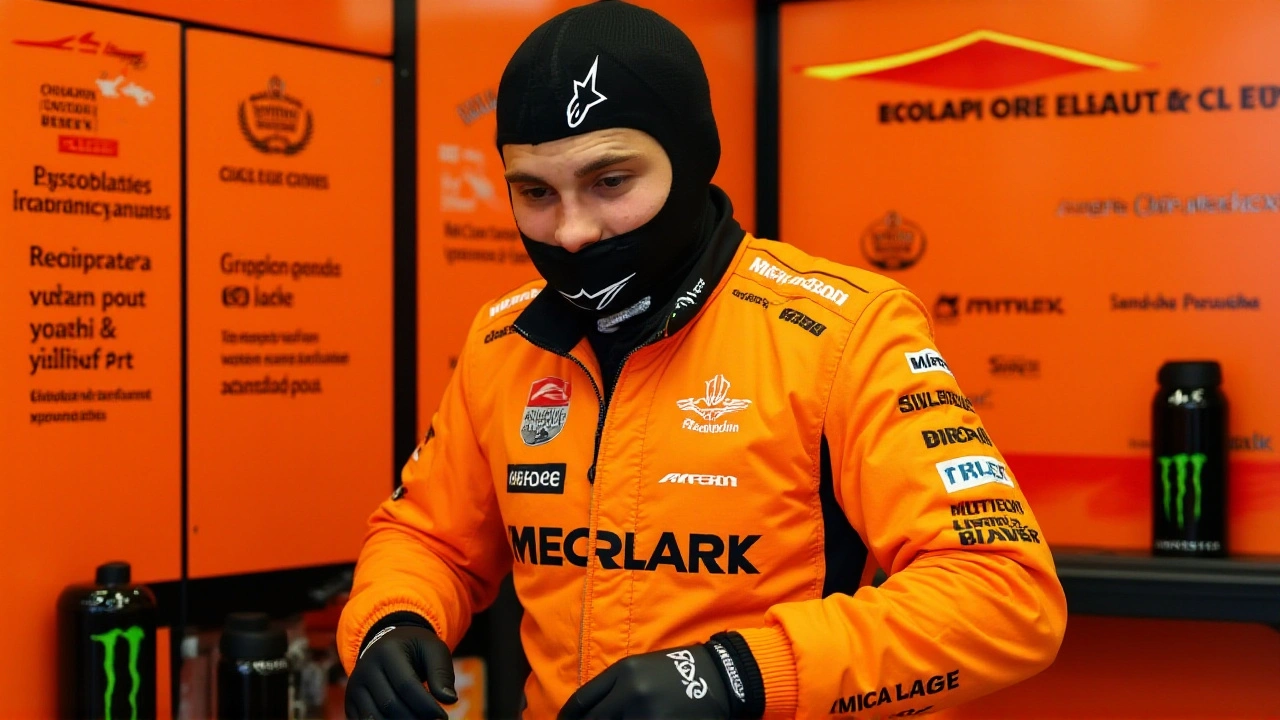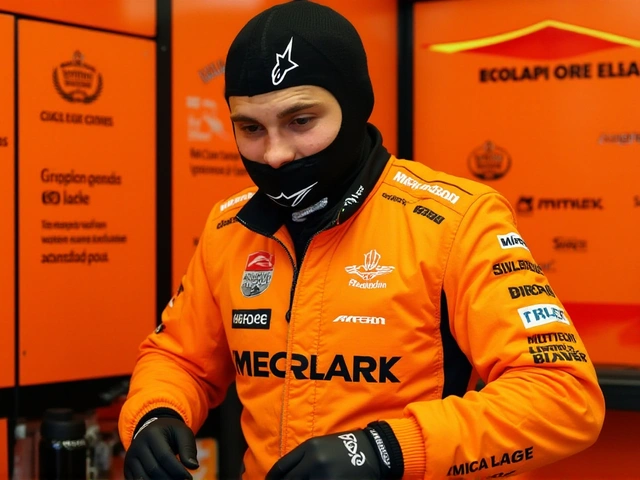
When the FIA officially declared the 2025 Singapore Grand Prix a heat hazard race, the motorsport world took notice. The announcement came on September 28, 2025, just days before the three‑day weekend at the 2025 Singapore Grand PrixMarina Bay Street Circuit in Singapore. Forecasts predicted daytime temperatures north of 30 °C with humidity hovering above 80 %, prompting the FIA to invoke its newly‑minted heat‑hazard protocol. The move forces every team to install a Driver Cooling System, though drivers may still opt out of wearing the fire‑proof cooling vest that threads chilled fluid across the torso.
Why Singapore Became a Heat Hazard Race
Singapore has long been tagged as the toughest stop on the calendar. The street circuit slices through the city’s skyline, featuring 23 tight corners, a notoriously bumpy surface, and a race that regularly pushes the two‑hour limit. Historically, Grand Prix durations average 1 hour 56 minutes, often trimmed by safety‑car periods. Add to that the tropical climate, and you get a perfect storm for driver fatigue.
The decision follows a sobering lesson from the 2023 Qatar Grand Prix. During that event, Esteban Ocon of Alpine vomited inside his helmet after a grueling stint, while Logan Sargeant of Williams was forced to retire because heat exhaustion left him unable to continue. Alex Albon and Lance Stroll also required medical checks post‑race. The tableau of drivers collapsing on pit‑lane steps convinced the governing body that a formal heat‑hazard classification was overdue.
What the New Cooling System Looks Like
The mandated Driver Cooling System (DCS) is a compact, closed‑loop apparatus that sits under the chassis. It comprises a high‑pressure pump, reinforced plumbing, and a thermal store unit that chugs cold fluid from a refrigerant bath. The chilled liquid travels via fire‑proof tubing sewn into a vest that drapes over the driver’s torso, circulating around the chest and back where body temperature spikes are most acute.
Teams must integrate the pump and thermal store before Friday’s free practice, according to technical delegate Ruth Buscombe. “We designed the system to be lightweight – under 2 kg – and to operate without compromising the car’s balance,” Buscombe told reporters. While the vest is optional, most drivers expressed willingness to test it after seeing the dehydration data from Qatar, where average body‑core temperatures rose above 39 °C in the latter stages of the race.
Feedback from Teams and Drivers
Alpine’s team principal Otmar Szafnauer praised the move: “If a cooling vest can shave a few seconds off recovery time between stints, it’s a win for both safety and performance.” Williams’ chief engineer Claire Williams echoed the sentiment, noting that the vest’s fire‑proof fabric aligns with existing FIA fire‑safety standards.
However, not everyone is convinced. Lewis Hamilton, a five‑time world champion, remarked in a post‑practice interview that “the feeling of a cold vest under the cockpit is foreign, but if it keeps you from feeling like a boiled lobster, I’m all for it.” The debate is likely to shape the degree of voluntary adoption once the race kicks off.

Potential Impact on Future Races
Should the Singapore experiment prove successful, the FIA hinted at expanding the heat‑hazard rule to any event where pre‑race forecasts cross the 30 °C/80 % humidity threshold. That could include the Las Vegas Grand Prix in November or even the United States Grand Prix at Austin if a heat wave rolls in.
From a strategic standpoint, teams now have to factor cooling‑system weight and power draw into their car‑setup calculations. The extra 2 kg, while seemingly minor, could influence tyre wear and fuel consumption over a 306‑km race distance. Engineers are already running simulations to see if the DCS can be paired with energy‑recovery systems without upsetting the delicate balance of power units.
Background: Lessons from Qatar and Beyond
The 2023 Qatar Grand Prix was a watershed moment. The desert venue, typically praised for its night‑time cool‑down, unexpectedly spiked to 39 °C with humidity at 70 % after a sudden sandstorm. The resulting medical tally read: three drivers hospitalized, five requiring hydration therapy, and one retirement due to heat exhaustion. The FIA’s subsequent safety review concluded that temperature alone wasn’t the enemy – it was the combination of humidity, chassis insulation, and the physical demands of a high‑downforce car.
Historically, F1 has addressed extreme conditions by adjusting race length or mandating tyre changes, but never by integrating a driver‑centric cooling device. The new rule, therefore, signals a shift toward protecting the human element of motorsport, aligning with broader trends in sports medicine that prioritize real‑time physiological monitoring.
Frequently Asked Questions
How will the cooling vest affect driver performance?
The vest is designed to keep core body temperature within a safe range, potentially reducing fatigue and improving reaction times. Early testing suggests drivers may recover faster between stints, though the added weight could marginally affect lap times.
What triggered the heat‑hazard designation for Singapore?
Meteorological models released a week before the event forecast daytime highs above 30 °C with humidity exceeding 80 %. Those figures crossed the FIA’s threshold for a heat‑hazard scenario, prompting the formal declaration.
Will other Grand Prix races adopt the same rule?
The FIA says the protocol is scalable. If future races—like Las Vegas or Austin—show similar temperature‑humidity combos, organizers will likely be required to implement the cooling system under the same guidelines.
Are teams allowed to modify the cooling system?
The system’s core components – pump, thermal store, and tubing – must meet FIA specifications, but teams can fine‑tune placement and integration to suit their chassis design, as long as the overall weight stays within the prescribed limit.
What medical data prompted the new safety rule?
Post‑race medical reports from Qatar showed average driver core temperatures climbing to 39.2 °C, with several cases of dehydration‑related nausea and one full‑race retirement. Those findings convinced the FIA that a proactive cooling solution was necessary.





Designating Singapore as a heat‑hazard race reflects a prudent acknowledgement of the physiological challenges drivers face. By mandating a driver‑cooling system, the FIA reduces the risk of heat‑induced errors that could compromise safety. The integration of a lightweight, closed‑loop apparatus under the chassis demonstrates thoughtful engineering. Moreover, the optional vest respects individual driver preferences while promoting a baseline of protection. This balanced approach honors both competitive integrity and human welfare.
Wow!!! This is such a game‑changer!!! The idea of a cooling vest might sound a bit sci‑fi, but it’s actually super practical!!! I love how the FIA is listening to drivers, even if the tech feels a little weird at first!!! It’ll keep us from feeling like boiled lobsters, right??!! Let’s hope the teams nail the fit – no sweaty sleeves!!
Another gimmick from the regulators!!! They’ll probably spend millions on something that adds two kilos and barely helps!!!
The physics of heat transfer dictate that a fluid loop with a high specific heat capacity will stabilize core temperature without adding significant thermal lag.
When you look at the data from Qatar, it becomes clear that the human body has a finite capacity to dissipate heat under extreme conditions. The core temperature spikes recorded there exceeded safe limits, leading to nausea and, in some cases, premature race withdrawal. By introducing a driver cooling system, we are effectively adding an active thermal regulation mechanism directly at the source of heat generation. The pump and thermal store, while modest in mass, provide a continuous flow of chilled fluid that absorbs excess heat from the torso. This not only lowers the immediate thermal stress but also improves recovery between stints, allowing drivers to maintain sharper focus for longer periods. From a strategic standpoint, teams will need to account for the two‑kilogram addition in their weight distribution calculations, which could influence tyre degradation patterns. However, the trade‑off is likely favorable, as cooler drivers can sustain higher brake temperatures without risking fatigue‑induced mistakes. Engineers will also have the opportunity to integrate the cooling loop with existing energy‑recovery systems, potentially recouping some of the power draw through regenerative braking. The fire‑proof nature of the vest ensures compliance with existing safety protocols while introducing a new layer of protection. In the broader context of motorsport safety, this move aligns with a growing emphasis on real‑time physiological monitoring and athlete welfare. If the Singapore experiment proves successful, it could set a precedent for future heat‑hazard classifications at venues like Las Vegas or Austin. The flexibility of the system allows for incremental upgrades, meaning teams can refine the design throughout the season. Moreover, driver feedback will be crucial in fine‑tuning the comfort and effectiveness of the vest. Ultimately, the integration of cooling technology represents a proactive step toward preserving both performance and health on the grid.
I think it’s great that teams can adapt the system to their chassis while still meeting the FIA specs. It shows a respect for engineering creativity across different racing cultures.
You’re absolutely right, the vest will keep drivers cool and safe.
While some may view this as an unnecessary expense, the long‑term health benefits and potential reduction in race‑day incidents justify the investment.
Let’s be clear – this is a solid step forward for driver safety 🚀👍.
Team collaboration will be key as we figure out the best placement for the cooling units. The added weight might shift balance, but that’s an engineering challenge we love. Drivers will appreciate the comfort and endurance boost during those scorching laps. This could set a new standard for race‑day preparedness.
It’s encouraging to see the sport taking proactive measures to protect its athletes and ensure peak performance during demanding conditions.